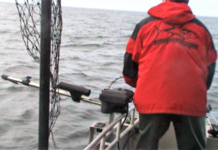
Many deep-sea organisms are able to emit “living light” through a chemical reaction, bringing light to the otherwise total darkness of the deep ocean. Image courtesy of Islands in the Sea 2002, NOAA/OER.
Bioluminescence, or the ability of an organism to create light, is one of nature’s most amazing phenomena, seemingly drawn more from science fiction than science and natural history. While only a few land dwellers, like fireflies and some fungi, can make their own light, bioluminescence is very common in the deep sea. Bacteria, jellyfish, starfish, clams, worms, crustaceans, squid, fish, and sharks are just some of the groups of marine animals that have bioluminescent members.
All bioluminescent organisms use a reaction between an enzyme and a substrate to make light, but different species use different chemicals in the process. This suggests that the ability to make light evolved many times throughout the ages. In fact, it is estimated that luminescence has evolved independently at least 40 times.
Deep-ocean environments are almost completely dark; yet light is still important in these environments. Thus, bioluminescence may provide a survival advantage in the darkness of the deep sea, helping organisms find food, assisting in reproductive processes, and providing defensive mechanisms.
However, although many marine species are able to produce this “living light,” very little is known about specific ways that deep-sea organisms use this ability. Part of the problem is that these organisms are difficult to observe: turning on bright lights can cause mobile animals to move away and may permanently blind light-sensitive sight organs. In addition, transparent and camouflaged organisms may be virtually invisible even with strong lights, and many types of bioluminescence can’t be seen under ordinary visible light. Additionally, collecting samples of these organisms is incredibly difficult.
For More Information:
Living Light (pdf, 1.2 Mb), Bioluminescence 2009: Living Light on the Deep-sea Floor
Bioluminescence, Bioluminescence 2009: Living Light on the Deep-sea Floor
Light at the Bottom of the Deep, Dark Ocean? (pdf, 194 kb), Islands in the Stream 2002: Exploring Underwater Oases
Sign up for the Ocean Explorer E-mail Update List.














